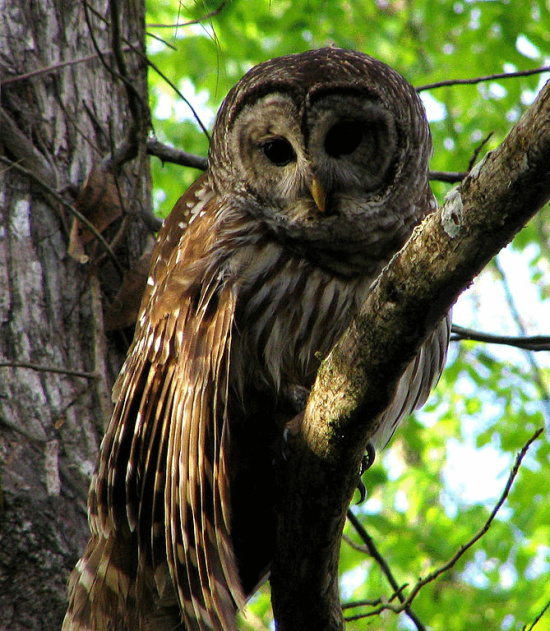Today the Outpost is pleased to launch the Internet’s newest feature: “LoCO Explains the Joke”! This fresh Outpost column takes submitted cartoons that trade in political or cultural criticism and makes them accessible to the widest possible Humboldt County audience, some members of which, perhaps because they are new around here, may not possess the referents to immediately “get” the cartoon as the rest of us will.
During the Pacific Northwest “Timber Wars” of the late 1980s and early 1990s, there was no more potent symbol of the division between environmental activists and the wood products industry than the northern spotted owl (Strix occidentalis caurina).
Strix occidentalis caurina. Photo: BLM. Public domain. Via Wikimedia Commons.
Long put forth as a “sentinel species” whose decline reflected vast problems in Northwest forest management practices, the spotted owl was finally listed as “threatened” under the federal Endangered Species Act in June 1990 – smack-dab in the middle of the Redwood Summer protests. Environmentalists viewed the owl’s listing status as a victory — not only would it mean that the owl would be accorded protection under the law, but the rapacious logging practices of the time could be challenged in court, because of their effect on the owl’s habitat. If an old-growth forest was home to a spotted owl, logging practices in that forest could be more strictly regulated, and perhaps curtailed entirely.
Timber industry folks, meanwhile, seized upon the same symbology and adapted it to their own purposes. At the time – and to this day, in fact – they held up the owl as a figure of federal overreach and an America gone mad. We’re losing our jobs because of an owl? they asked of anyone who would listen. Defiant bumper stickers disdaining the owl, and sometimes offering recipes for its consumption, were pasted on pickups throughout the region, where they may still be seen from time to time.
Decal typical of the period.
The reasons for the subsequent decline of the Northern California timber industry are complex – too complex to treat in detail here – but certainly it may be said that the protection of the owl did, in fact, help slow the historically unprecedented rate of logging happening at the time. Timber harvesters still employ biologists to determine the presence of the owl on lands they plan to harvest, and they must by law adjust their plans if one is found.
Strix varia. Photo: Mwanner, Creative Commons license. Via Wikimedia Commons.
In recent years, though, scientists have discovered that the northern spotted owl is facing a new threat: The barred owl (Strix varia), a Midwestern bird that has been expanding its range into the Pacific and displacing its native, spotted cousin. Their threat to the local owl is great enough that federal agencies have begun killing barred owls found invading spotted owl territory.
A few more notes. Many conservation organizations employ Washington lobbyists to influence policy decisions in Congress (“Capitol Hill”), and often those organizations seek legislation that will benefit various classes of fauna — e.g., an owl. However, the thought of animals themselves directly employing lobbyists is whimsical and, it is to be hoped, humorous. Animals have no money.
Also: In the English language, the owl’s call is usually transliterated as “hoo.” This is nearly always followed by an exclamation point. When said out loud, this word – “hoo!” – is pronounced as a homophone of a certain common relative pronoun with which you may be familiar.
OK! You now have enough background to understand the joke contained in the following cartoon, which comes to us from LoCO reader Peggy Molloy:
###
Got a Humboldt-themed cartoon that might need a little explaining? Submit it to news@lostcoastoutpost.com and put “LoCO Explains the Joke” in the title.




CLICK TO MANAGE